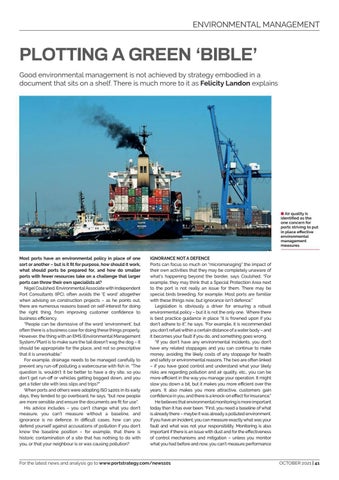ENVIRONMENTAL MANAGEMENT
PLOTTING A GREEN ‘BIBLE’ Good environmental management is not achieved by strategy embodied in a document that sits on a shelf. There is much more to it as Felicity Landon explains
8 Air quality is identified as the one concern for ports striving to put in place effective environmental management measures
Most ports have an environmental policy in place of one sort or another – but is it fit for purpose, how should it work, what should ports be prepared for, and how do smaller ports with fewer resources take on a challenge that larger ports can throw their own specialists at? Nigel Coulshed, Environmental Associate with Independent Port Consultants (IPC), often avoids the ‘E word’ altogether when advising on construction projects – as he points out, there are numerous reasons based on self-interest for doing the right thing, from improving customer confidence to business efficiency. “People can be dismissive of the word ‘environment’, but often there is a business case for doing these things properly. However, the thing with an EMS (Environmental Management System/Plan) is to make sure the tail doesn’t wag the dog – it should be appropriate for the place, and not so prescriptive that it is unworkable.” For example, drainage needs to be managed carefully to prevent any run-off polluting a watercourse with fish in. “The question is, wouldn’t it be better to have a dry site, so you don’t get run-off or vehicles getting bogged down, and you get a tidier site with less slips and trips?” When ports and others were adopting ISO 14001 in its early days, they tended to go overboard, he says, “but now people are more sensible and ensure the documents are fit for use”. His advice includes – you can’t change what you don’t measure, you can’t measure without a baseline, and ignorance is no defence. In difficult cases, how can you defend yourself against accusations of pollution if you don’t know the baseline position – for example, that there is historic contamination of a site that has nothing to do with you, or that your neighbour is or was causing pollution?
IGNORANCE NOT A DEFENCE Ports can focus so much on “micromanaging” the impact of their own activities that they may be completely unaware of what’s happening beyond the border, says Coulshed. “For example, they may think that a Special Protection Area next to the port is not really an issue for them. There may be special birds breeding, for example. Most ports are familiar with these things now, but ignorance isn’t defence.” Legislation is obviously a driver for ensuring a robust environmental policy – but it is not the only one. Where there is best practice guidance in place “it is frowned upon if you don’t adhere to it”, he says. “For example, it is recommended you don’t refuel within a certain distance of a water body – and it becomes your fault if you do, and something goes wrong. “If you don’t have any environmental incidents, you don’t have any related stoppages and you can continue to make money, avoiding the likely costs of any stoppage for health and safety or environmental reasons. The two are often linked – if you have good control and understand what your likely risks are regarding pollution and air quality, etc., you can be more efficient in the way you manage your operation. It might slow you down a bit, but it makes you more efficient over the years. It also makes you more attractive, customers gain confidence in you, and there is a knock-on effect for insurance.” He believes that environmental monitoring is more important today than it has ever been. “First, you need a baseline of what is already there – maybe it was already a polluted environment. If you have an incident, you can measure exactly what was your fault and what was not your responsibility. Monitoring is also important if there is an issue with dust and for the effectiveness of control mechanisms and mitigation – unless you monitor what you had before and now, you can’t measure performance
For the latest news and analysis go to www.portstrategy.com/news101
OCTOBER 2021 | 41











